How to Use Edit Toolpath - Break
Introduction
This example explains how to use the Break option in the Edit Toolpath dialog box. On our example part, we have used a solid model to set the stock to a specific shape. In this case, the stock shape shows what the first two operations have left. Due to the size of the rough tool, much more material has been left in the acute angles of our pocket. It is because of this, it would be beneficial to slow down the feedrate on our finish operation before it engages that extra material.To accomplish this, we will need to break the toolpath elements leading into, and out of, our acute angles. Once this is accomplished, we can adjust the feedrate on the specific portions of toolpath that engage the leftover material,which will be accomplished in another example. This example will have you:
- Viewing the Stock and Toolpath
- Opening the Edit Toolpath Dialog Box
- Setting the Command Mode
- Adjusting Parameters
- Selecting Toolpath Elements
- Adjusting Distance
- Executing the Action
- Viewing the Animation
- Exiting the Edit Toolpath Dialog
- Example Part
Example Part
If you are connected to the Internet, the part file for this example can be downloaded automatically by clicking the following link: Toolpath_Editor_Break_Example.sldprt
Once you download and saved the zip file, extract the files on your system in an easy place to remember.You can then open the file to use with this tutorial. All files for the tutorials in this help system available for download can be found by clicking on the following link: http://www.bobcad.com/helpfiles.
In the example file provided, the stock and MachineSetup are already defined for the part, and the toolpath to be adjusted has been applied.
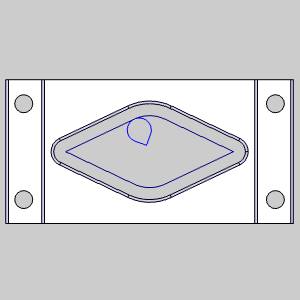
Part 1) Viewing the Stock and Toolpath
Take a moment to look at the stock compared to the existing toolpath to see the what we intend to accomplish.
-
In the CAM Tree, click
 Stockto view the assigned stock.
Stockto view the assigned stock.
Take a moment to look at the existing stock compared to the existingtoolpath to get an idea of where we would like to break our toolpath elements.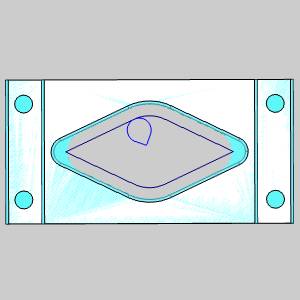
-
In the CAM Tree, click the Pocket operation in the feature to remove focus on the stock and to place focus on the toolpath to be adjusted.
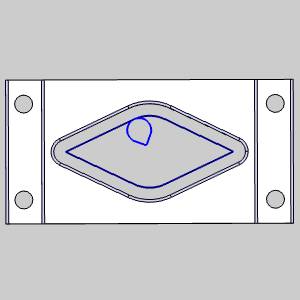
Part 2) Opening the Edit Toolpath Dialog Box
The Edit Toolpath function is only applied to individual operations, as such, the first step is always to right-click on the operation to be adjusted.
-
Right-click the ProfileFinish operation of the second feature 2 Axis.
-
Select Edit Toolpath.
The Edit Toolpath dialog appears.
Part 3) Setting the Command Mode
The Edit Toolpath dialog gives you access to eight different CommandModes. For this example, we will be utilizing the Break Command Mode.
-
Click the arrow on the CommandMode list to view the list items.
-
Select the Breakoption.
-
By default, the Previewcheck box is already selected. Leave this check box selected, as it will allow us to see a preview of the executable result.
Part 4) Adjusting Parameters
Change Parameters to the Screen Point option.
-
Select the ScreenPoint option in the Parameters group.
Part 5) Selecting Toolpath Elements
Select the toolpath to be edited.
-
In the graphics area, select the toolpath shown in the images below.
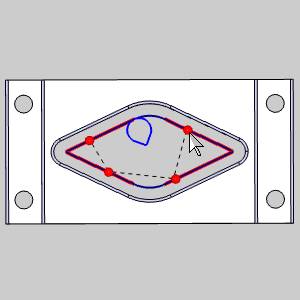
Notice that as the points are selected, and are added to the Screen Point list, the associated toolpath elements are added to the Selected Toolpath list automatically.
Part 6) Adjusting Distance
With the toolpath elements selected, we will need to define the distance of the Break Point.
-
In the Break Point list, select BreakPoint - 1.
Break Point - 1 highlights in the graphics area.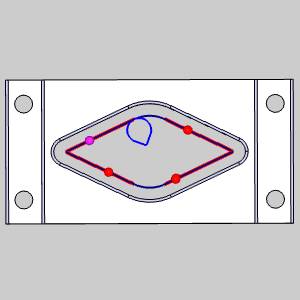
-
Change the Distanceto 70.
-
In the Break Point list, Select BreakPoint - 2.
Break Point -1 adjusts its position in the graphics area and BreakPoint - 2 highlights.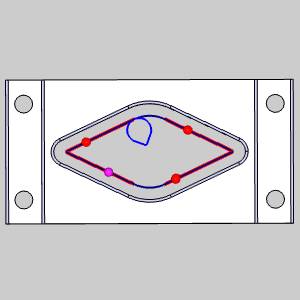
-
Change the Distanceto 30.
-
In the Break Point list, Select BreakPoint - 3.
Break Point -2 adjusts its position in the graphics area and BreakPoint - 3 highlights.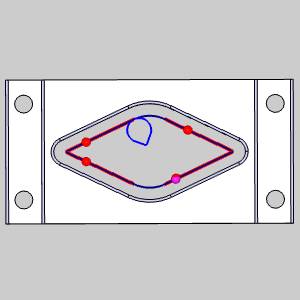
-
Change the Distanceto 70.
-
In the Break Point list, Select BreakPoint - 4.
Break Point -3 adjusts its position in the graphics area and BreakPoint - 4 highlights.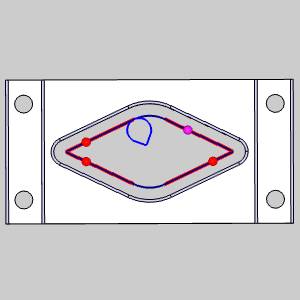
-
Change the Distanceto 30.
Part 7) Executing the Action
To move beyond the preview, and before clicking OK to finalize and exit,it is a good idea to Execute the current settings. Although clicking OK will Execute and exit simultaneously, using Execute will allow you to use Animation to verify the results and Undo the executed command if and adjustments necessary.
-
Click Execute.
Break Point -4 adjusts its position in the graphics area, and the toolpath elements update.
Part 8) Viewing the Animation
The Animation is an excellent way to double check the edits we have made to our toolpath elements. If any issues are noticed in the animation, we can easily undo our edits and make the necessary adjustments.
-
Select the check box for Animation.
The tool appears in the graphics area at the start of our toolpath. -
Use the Animation controls to play through the animation. With either the
 (Solid),
(Solid),  (Transparent), or
(Transparent), or  (Wireframe)view.
(Wireframe)view.
Part 9) Exiting the Edit Toolpath Dialog
Once the Animation has been viewed to ensure no further edits are needed, click OK to finalize and exit the Edit Toolpath Dialog. If you need to change the toolpath to its original state after clicking OK, recompute the operation.
-
Click OK.
The Edit Toolpath Dialog closes.
Important: Once the toolpath of an operation has been edited, the operation will be locked. In the CAM Tree, to the left of the operation name, which will be shown in red font, you will notice a lock icon:  . This ensures the toolpath can not be accidentally recalculated. To return the toolpath to its original state, or to update the operation with the wizard, and recalculate the toolpath, you must first right-click the operation and select Lock/Unlock Operation. The toolpath can then be recalculated to undo the edits that have been made to it with the Edit Toolpath dialog.
. This ensures the toolpath can not be accidentally recalculated. To return the toolpath to its original state, or to update the operation with the wizard, and recalculate the toolpath, you must first right-click the operation and select Lock/Unlock Operation. The toolpath can then be recalculated to undo the edits that have been made to it with the Edit Toolpath dialog.
This concludes this example.






